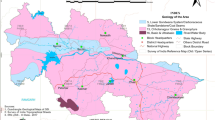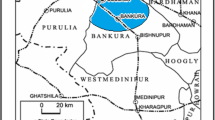Abstract
The main aim of the study is to present an evaluation of radon concentration in underground water of Bakreswar and Tantloi geothermal region which is mainly used for drinking purposes of the local people. Water samples were collected from tube-wells at 173 different locations. The radon (222Rn) concentration level was observed to fluctuate widely between 3.3 and 803.8 Bq/l with an average of 106.8 Bq/l. Nearly 42% of the samples had radon concentration above the safe limit of 100 Bq/l recommended by World Health Organisation (WHO) and European Union Commission (EU). Considering the WHO and International Commission on Radiological Protection recommended water consumption rate for adults (730 l/year) the corresponding total annual effective dose of the samples were estimated to assess the probable health risk. Total annual effective dose of the samples were varied between 16.72 and 4079.47 µSv/year with an average value of 541.92 µSv/year. About 95% samples exceed the WHO and EU Commission proposed safe limit of 100 µSv/year.







Similar content being viewed by others
References
UNSCEAR (2000) Sources and effects of atomic radiation, report to General Assembly, Annex B. United Nations, New York
Somlai K, Tokonami S, Ishikawa T, Vancsura P, Gáspár M, Jobbágy V, Somlai J, Kovács T (2007) 222 Rn concentrations of water in the Balaton Highland and in the southern part of Hungary, and the assessment of the resulting dose. Radiat Meas 42(3):491–495
Evans RD (1980) Engineers’ guide to the elementary behavior of radon daughters. Health Phys 38(6):1173–1197
Wanty RB, Gundersen L (1998) Groundwater geochemistry and radon-222 distribution in two sites on the Reading Prong, Eastern Pennsylvania. Missouri Department of Natural Resources Special Publication 4
Michel J (1990) Relationship of radium and radon with geological formations. Radon Radium Uranium Drink Water 7:83–95
Choubey V, Ramola R (1997) Correlation between geology and radon levels in groundwater, soil and indoor air in Bhilangana Valley, Garhwal Himalaya, India. Environ Geol 32(4):258–262
Ball T, Cameron D, Colman T, Roberts P (1991) Behaviour of radon in the geological environment: a review. Q J Eng Geol Hydrogeol 24(2):169–182
Banwell G, Parizek R (1988) Helium 4 and radon 222 concentrations in groundwater and soil gas as indicators of zones of fracture concentration in unexposed rock. J Geophys Res 93(B1):355–366
Lawrence E, Poeter E, Wanty R (1991) Geohydrologic, geochemical, and geologic controls on the occurrence of radon in ground water near Conifer, Colorado, USA. J Hydrol 127(1–4):367–386
Bonotto DM, Caprioglio L (2002) Radon in groundwaters from Guarany aquifer, South America: environmental and exploration implications. Appl Radiat Isotopes 57(6):931–940
Hoehn E, Von Gunten H (1989) Radon in groundwater: a tool to assess infiltration from surface waters to aquifers. Water Resour Res 25(8):1795–1803
Ramola R, Negi M, Choubey V (2005) Radon and thoron monitoring in the environment of Kumaun Himalayas: survey and outcomes. J Environ Radioact 79(1):85–92
Gurav T, Chandrasekharam D, Singh HK (2015) Trace element and REE concentrations in the thermal waters, West Coast Geothermal Province, India. In: Proceedings World Geothermal Congress, Melbourne, Australia, pp 19–25
Majumdar R, Majumdar N, Mukherjee A (2000) Geoelectric investigations in Bakreswar geothermal area, West Bengal, India. J Appl Geophys 45(3):187–202
Khattak N, Khan MA, Ali N, Abbas SM (2011) Radon monitoring for geological exploration: a review. J Himal Earth Sci 44(2):91–102
Kendall G, Smith T (2002) Doses to organs and tissues from radon and its decay products. J Radiol Prot 22(4):389
Binesh A, Mowlavi A, Mohammadi S (2012) Estimation of the effective dose from radon ingestion and inhalation in drinking water sources of Mashhad, Iran. Iran J Radiat Res 10(1):37–41
McKittrick L, Sequeira S, Ryan T, Colgan T (2003) Radon in drinking water in county Wicklow—a pilot study. In: Diffuse Pollution Conference 8B Ecology, p 831
Report NRC (1999) National Research Council Risk assessment of radon in drinking water. National Academy Press, Washington, DC
Sethy N, Jha V, Ravi P, Tripathi R (2015) Jaduguda, Jharkhand, India. Curr Sci 109(10):1855
Xinwei L (2006) Analysis of radon concentration in drinking water in Baoji (China) and the associated health effects. Radiat Prot Dosim 121(4):452–455
Singh J, Singh H, Singh S, Bajwa B (2009) Estimation of uranium and radon concentration in some drinking water samples of Upper Siwaliks, India. Environ Monit Assess 154(1):15–22
Prasad G, Prasad Y, Gusain G, Ramola R (2008) Measurement of radon and thoron levels in soil, water and indoor atmosphere of Budhakedar in Garhwal Himalaya, India. Radiat Meas 43:S375–S379
Galan Lopez M, Martin Sanchez A, Gómez Escobar V (2004) Application of ultra-low level liquid scintillation to the determination of 222Rn in groundwater. J Radioanal Nuclear Chem 261(3):631–636
Nikolopoulos D, Louizi A (2008) Study of indoor radon and radon in drinking water in Greece and Cyprus: implications to exposure and dose. Radiat Meas 43(7):1305–1314
Horvath A, Bohus L, Urbani F, Marx G, Piroth A, Greaves E (2000) Radon concentrations in hot spring waters in northern Venezuela. J Environ Radioact 47(2):127–133
Przylibski TA (2011) Shallow circulation groundwater-the main type of water containing hazardous radon concentration. Nat Hazards Earth Syst Sci 11(6):1695
Tsvetkova T, Nevinsky I, Suyatin B, Akkurt I, Kulali F (2016) Application of the nuclear analytical chemistry (NAC) methods in seismological researches of mud volcanoes and springs in the Black Sea zone. J Radioanal Nucl Chem 307(1):169–178
Abdallah SM, Habib RR, Nuwayhid RY, Chatila M, Katul G (2007) Radon measurements in well and spring water in Lebanon. Radiat Meas 42(2):298–303
Cosma C, Moldovan M, Dicu T, Kovacs T (2008) Radon in water from Transylvania (Romania). Radiat Meas 43(8):1423–1428
Marques AL, dos Santos W, Geraldo LP (2004) Direct measurements of radon activity in water from various natural sources using nuclear track detectors. Appl Radiat Isotopes 60(6):801–804
Shiva Prasad N, Nagaiah N, Ashok G, Mahesh H (2007) Radiation dose from dissolved radon in potable waters of the Bangalore environment, South India. Int J Environ Stud 64(1):83–92
Chandrashekara M, Veda S, Paramesh L (2011) Studies on radiation dose due to radioactive elements present in ground water and soil samples around Mysore city, India. Radiat Prot Dosim 149(3):315–320
Duggal V, Mehra R, Rani A (2013) Determination of 222Rn level in groundwater using a RAD7 detector in the Bathinda district of Punjab, India. Radiat Prot Dosim 156(2):239–245
Choubey V, Bartarya S, Ramola R (2003) Radon in groundwater of eastern Doon valley, Outer Himalaya. Radiat Meas 36(1):401–405
Rani A, Mehra R, Duggal V (2012) Radon monitoring in groundwater samples from some areas of northern Rajasthan, India, using a RAD7 detector. Radiat Prot Dosim 153(4):496–501
Krishan G, Rao M, Kumar C, Semwal P (2015) Radon concentration in groundwater of east coast of West Bengal, India. J Radioanal Nucl Chem 303(3):2221–2225
Singh HK, Chandrasekharam D, Trupti G, Singh B (2015) Geochemical characteristic of Bakreshwar and Tantoli Geothermal Province, India, Proceedings World Geothermal Congress, pp 1–5
Ghose D, Chowdhury D, Sinha B (2002) Large-scale helium escape from earth surface around Bakreswar–Tantloi geothermal area in Birbhum district, West Bengal, and Dumka district, Jharkhand, India. Current Science, pp 993–996
Chaudhuri H, Das NK, Bhandari RK, Sen P, Sinha B (2010) Radon activity measurements around Bakreswar thermal springs. Radiat Meas 45(1):143–146
Majumdar N, Majumdar R, Mukherjee A, Bhattacharya S, Jani R (2005) Seasonal variations in the isotopes of oxygen and hydrogen in geothermal waters from Bakreswar and Tantloi, Eastern India: implications for groundwater characterization. J Asian Earth Sci 25(2):269–278
Shanker R (1988) Heat-flow map of India and discussions on its geological and economic significance. Indian Miner 42(2):89–110
GSI, Kolkata (1991) Geological Survey of India. Geothermal Atlas of India, Spl. Publ. 19, pp 110–113
Nagar R, Vishwanathan G, Sagar S, Sankaranaraanan A (1996) Geological, geophysical and geochemical investigations in bakreshwar-tantloi thermal field, birbhum and santhal parganas districts, west bengal and bi har, india. Visesa Prakasana-Bharatiya Bhuvaijñanika Sarveksana 45:349–360
Majumdar R, Majumdar N, Mukherjee A (2000) Geoelectric investigations in Bakreswar geothermal area, West Bengal, India. J Appl Geophys 45:187–202
Deb S, Mukherjee A (1969) On the genesis of a few groups of thermal springs in the Chotanagpur Gneissic Complex, India. J Geochem Soc India 4:1–9
Mukhopadhyay DK, Sarolkar PB (2012) Geochemical appraisal of Bakreshwar–Tantloi hot springs, West Bengal and Jharkhand, India. In: Proceedings, thirty-seventh workshop on geothermal reservoir engineering. Stanford University, Stanford, California, pp 1–5
Majumdar RK, Majumdar N, Mukherjee A (2010) Geological, geochemical and geoelectric studies for hydrological characterization and assessment of Bakreswar thermal springs in hard rock areas of Birbhum district, West Bengal, India. In: 8th Biennial International Conference & Exposition on Petroleum Geophysics, Hyderabad, p 186
Jobbagy V, Altzitzoglou T, Malo P, Tanner V, Hult M (2017) A brief overview on radon measurements in drinking water
Instruments G (1998) AlphaGUARD portable radon monitors user manual. Germany
UNSCER (2008) United Nations. Scientific Committee on the Effects of Atomic Radiation. Report of the United Nations Scientific Committee on the Effects of Atomic Radiation: Fifty-sixth Session (10–18 July 2008) (No. 46). United Nations Publications
Sujo LC, Cabrera MM, Villalba L, Villalobos MR, Moye ET, Leon MG, García-Tenorio R, García FM, Peraza EH, Aroche DS (2004) Uranium-238 and thorium-232 series concentrations in soil, radon-222 indoor and drinking water concentrations and dose assessment in the city of Aldama, Chihuahua, Mexico. J Environ Radioact 77(2):205–219
Thabayneh KM (2015) Measurement of 222Rn concentration levels in drinking water and the associated health effects in the Southern part of West bank–Palestine. Appl Radiat Isotopes 103:48–53
Hopkins KD, Weeks DL (1990) Tests for normality and measures of skewness and kurtosis: their place in research reporting. Educ Psychol Meas 50(4):717–729
Press WH (1992) The art of scientific computing. Cambridge University Press, Cambridge
EPA (1991) US Environmental Protection Agency. National primary drinking water regulations; radionuclides; proposed rules. Fed regist 56(138):33050
EPA (1988) US Environmental Protection Agency. Radon reduction techniques for detached houses: technical guidance. EPA, Washington, p 520
WHO (2011) World Health Organization.Guidelines for drinking-water quality. Chapter 9. Radiological aspects. 4. Geneva
EU (2001) European Union Commission Recommendation on the protection of the public against exposure to radon in drinking water supplies. Office J Eur Commun, L 344, pp 85–88
Synnott H, Fenton D (2005) An evaluation of radon mapping techniques in Europe. European Radon Research and Industry Collaborative Concerted Action (ERRICCA 2), European Commission Contract (FIRI-CT-2001-20142)
ICRP (2010) International Commission on Radiological Protection. Lung cancer risk from radon and progeny. Publication 115. Ann ICRP 40(1):1–64
WHO (2009) World Health Organization. Handbook on indoor radon, a public health perspective. Geneva
WHO (2004) World Health Organization. Expert consultation—“Appropriate body-mass index for Asian populations and its implications for policy and intervention strategies.” Lancet. London, England 363.9403(2004):157
EU (2005) European Union Commission. Progress Report. Brussels, 9 November 2005. SEC (2005) 1426
EPA (2016) Consumer’s Guide to Radon Reduction: How to Fix Your Home. (DOI EPA 402/K-10/005 | 2016 | www.epa.gov/radon)
Acknowledgements
The authors are thankful to all the laboratory members of Bakreswar Helium Laboratory for their great support and cooperation & DST FIST project of the department of Physics, Jadavpur University for financial support in procuring the measuring instrument.
Author information
Authors and Affiliations
Corresponding author
Rights and permissions
About this article
Cite this article
Naskar, A.K., Gazi, M., Barman, C. et al. Estimation of underground water radon danger in Bakreswar and Tantloi Geothermal Region, India. J Radioanal Nucl Chem 315, 273–283 (2018). https://doi.org/10.1007/s10967-017-5668-1
Received:
Published:
Issue Date:
DOI: https://doi.org/10.1007/s10967-017-5668-1




